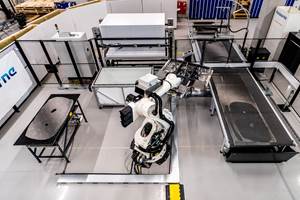All-composite EV wheel moves to next development phase
U.K. consortium partners’ ACRIM II project aims to develop a low-cost, lightweight, all-composite wheel for electric vehicle applications.

It was reported on March 9 that consortium partners Carbon ThreeSixty (Chippenham, U.K.), Far-UK (Nottingham, U.K.), Composite Integration (Cornwall, U.K.), CNC Robotics (Liverpool, U.K.) and Bitrez Ltd. (Standish, U.K.), have moved the ACRIM-Wheel — what is said to be first commercially viable, low-cost, lightweight, all-composite wheel for niche and electric vehicle (EV) applications — to the next phase of development, after its successful completion of the program’s second phase. The second phase, which involved development and validation of proof-of-concept, confirmed the design’s feasibility of achieving significant cost reductions over existing global market offerings. The consortium aims to manufacture fifty wheels by the end of 2020.
Further developments include three full vehicle sets, and two sets of overmolded RTM wheels which are headed for qualification testing. The vehicle sets are also to be tested on MOTIV, a versatile autonomous mobility vehicle using model design company Gordon Murray Design’s (Guildford, U.K.) iStream Superlight technology which approaches automotive production with vehicle lightweighting goals.
According to the partners, the work being undertaken will enable wider access to key lightweighting technologies for the lower volume niche automotive manufacturers. The product development consortium previously made a number of key findings, with a highlight being that the modular concept of ACRIM offers unrivalled flexibility in the styling and configuration of lightweight all-composite wheels. This puts it firmly on track to reduce the weight of, for example, a 15-inch wheel by 50%, which would deliver 5% fuel savings or a 5% CO2 reduction when retrofitted to a petrol- or diesel-fueled vehicle.

MOTIV autonomous vehicle platform
The ACRIM modular concept being applied to this project is said to enable the creation of wheels ranging from a “traditional” two-piece bolted metallic center with a composite barrel (mature, low risk architecture) through to an overmolded all-composite wheel.
The consortia contends that the demonstration of an SMC overmolded center into a continuous fiber RTM’d barrel offers early indication of high-volume capability and short route to manufacture. The ACRIM modular platform is also said to enable a tiered approach to OEMs in specifying lightweight wheels depending on their appetite for disruptive innovation.
For the next phase, which kicked off this past summer, the consortium aimed to decrease manufacturing cost and cycle time with a multi-strand approach. Avenues include processing of a three-component epoxy resin system with an in-mold release agent, piston pump technology to deliver repeatable and higher quality lamination through increased control and monitoring of the preconditioning of resin prior to injection (metering, mixing, pre-heating and degassing) and a mold pressure closed loop control system to improve yield.
The production scale-up project also aims to prove that robotic machining can be sufficiently accurate and repeatable for secondary machining over conventional machining tools, including trimming and drilling of composite components. This, the partners say, can offer fast and flexible operation that opens the door to reduced skilled labor content.
According to the partners, the product has been evolving as well. This includes the consortia’s optimization of the part’s design to minimum weight and cost with an automatic analysis of manufacturability, particularly CFD material flow. It also plans to prove the manufacturing robustness of the novel overmolding process for a high reliability structural component.
“The world’s first all-composite wheel for electric and niche vehicles has moved a major step forward, and we can confidently say it has the ability to deliver huge cost savings over anything on the market. It can also be manufactured in volume and gives OEMs huge flexibility in what they can specify. This is truly a quantum leap in wheel design and manufacture,” notes lead project partner, Edward Allnutt, managing director at Carbon ThreeSixty.
According to the consortia, previously seen to be purely performance driven for racing and high-performance applications, lightweight carbon wheels are now being investigated by electric and niche vehicles and OEMs to further reduce fuel consumption, emissions, extend vehicle range and increase payload.
Related Content
ASCEND program update: Designing next-gen, high-rate auto and aerospace composites
GKN Aerospace, McLaren Automotive and U.K.-based partners share goals and progress aiming at high-rate, Industry 4.0-enabled, sustainable materials and processes.
Read MoreAirbus selects Airborne to supply automated ply placement system
The pick-and-place system with software-driven automated will be the first in Airbus facilities, enabling highly efficient and flexible dry fiber preform manufacture for A350 structures.
Read MorePlant tour: BeSpline/Addcomp, Sherbrooke, QC, Canada
Composites automation specialist increases access to next-gen technologies, including novel AFP systems and unique 3D parts using adaptive molds.
Read MoreAirborne, Accudyne partner to provide automated composites solutions worldwide
The two companies have signed an MOA to collaborate on further development of digital automation systems for composites manufacturing in aerospace, renewable energy, future mobility and more.
Read MoreRead Next
All-recycled, needle-punched nonwoven CFRP slashes carbon footprint of Formula 2 seat
Dallara and Tenowo collaborate to produce a race-ready Formula 2 seat using recycled carbon fiber, reducing CO2 emissions by 97.5% compared to virgin materials.
Read MoreDeveloping bonded composite repair for ships, offshore units
Bureau Veritas and industry partners issue guidelines and pave the way for certification via StrengthBond Offshore project.
Read MorePlant tour: Daher Shap’in TechCenter and composites production plant, Saint-Aignan-de-Grandlieu, France
Co-located R&D and production advance OOA thermosets, thermoplastics, welding, recycling and digital technologies for faster processing and certification of lighter, more sustainable composites.
Read More












.jpg;maxWidth=300;quality=90)












